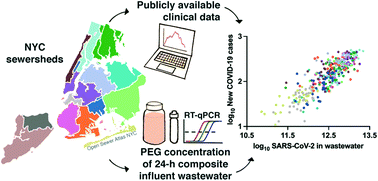Monitoring SARS-CoV-2 in wastewater during New York City's second wave of COVID-19: sewershed-level trends and relationships to publicly available clinical testing data†
Abstract
New York City's wastewater monitoring program tracked trends in sewershed-level SARS-CoV-2 loads starting in the fall of 2020, just before the start of the city's second wave of the COVID-19 outbreak. During a five-month study period, from November 8, 2020 to April 11, 2021, viral loads in influent wastewater from each of New York City's 14 wastewater treatment plants were measured and compared to new laboratory-confirmed COVID-19 cases for the populations in each corresponding sewershed, estimated from publicly available clinical testing data. We found significant positive correlations between viral loads in wastewater and new COVID-19 cases. The strength of the correlations varied depending on the sewershed, with Spearman's rank correlation coefficients ranging between 0.38 and 0.81 (mean = 0.55). Based on a linear regression analysis of a combined data set for New York City, we found that a 1 log10 change in the SARS-CoV-2 viral load in wastewater corresponded to a 0.6 log10 change in the number of new laboratory-confirmed COVID-19 cases per day in a sewershed. An estimated minimum detectable case rate between 2–8 cases per day/100 000 people was associated with the method limit of detection in wastewater. This work offers a preliminary assessment of the relationship between wastewater monitoring data and clinical testing data in New York City. While routine monitoring and method optimization continue, information on the development of New York City's wastewater monitoring program may provide insights for similar wastewater-based epidemiology efforts in the future.

- This article is part of the themed collections: Recent Open Access Articles, Best Papers 2022 – Environmental Science: Water Research & Technology and Environmental Science – coronavirus research


 Please wait while we load your content...
Please wait while we load your content...